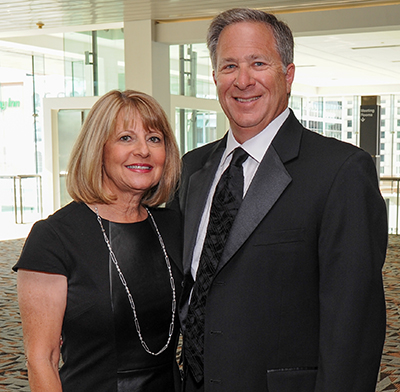 Cancer cells draw their
destructive strength from
an infinite ability to reproduce.
Now, with help
from a longtime leader
and philanthropic partner, scientists
at the University of Maryland Marlene
and Stewart Greenebaum Cancer
Center (UMGCC) have begun to crack this immortal
cancer code, opening the door
to future treatments that may literally
stop cancer dead in its tracks.
Cancer cells draw their
destructive strength from
an infinite ability to reproduce.
Now, with help
from a longtime leader
and philanthropic partner, scientists
at the University of Maryland Marlene
and Stewart Greenebaum Cancer
Center (UMGCC) have begun to crack this immortal
cancer code, opening the door
to future treatments that may literally
stop cancer dead in its tracks.
“Although normal cells divide a finite number of times before they begin to age, I discovered that stem cells can actually reset their age using a special mechanism,” says pioneering stem cell researcher Michal Zalzman, PhD, who was with the National Institutes of Health at the time of her discovery.
Acting on her “strong hunch” that the mechanism was somehow implicated in the endless proliferation of can-cer cells, she discussed her work with renowned UMGCC head and neck surgeon and scientist Rodney Taylor, MD, MPH. Soon after forming their novel collaboration, Dr. Zalzman joined the team at UMGCC. “This team is a family full of committed, smart and fun people,” Dr. Taylor says. “Dr. Zalzman fit that bill.”
To move their revolutionary idea forward at a rapid pace, an infusion of funding was needed—and it came in the form of a critical philanthropic investment from the Weitzman family.
“I’ve had the privilege of knowing the Weitzmans for more than a decade,” Dr. Taylor says, referring to his lifesaving treatment of the young Jill Weitzman for thyroid cancer in 2003. “They really understand what curing cancer requires.”
Stuart Weitzman, Jill’s father and a UMGCC board member at the time of her diagnosis, established the Weitzman Family Fund as a way to honor Dr. Taylor and support his team’s groundbreaking studies on the disease.
“The outstanding care and warmth of Dr. Taylor and his team made us feel a bond with UMGCC,” recalls Mr. Weitzman. “My wife, Lynne, and I sent a letter to all of our friends, pledging to match their gifts to the Weitzman Family Fund, dollar-for-dollar. We raised more than $100,000 back then, and the gifts continue to come in even now.”
The experience further strengthened his relationship with the Cancer Center, leading him to become board chair—a position he has held since 2004, the same year in which another esteemed head and neck oncologist, Kevin Cullen, MD, became director of UMGCC. Over the next 10 years, they would work with the entire Cancer Center community of faculty, staff, philanthropists and volunteers to help UMGCC become one of U.S.News & World Report’s top 50 cancer hospitals and one of only 68 National Cancer Institute-designated cancer centers in the country.
Drs. Taylor and Zalzman recently made an unprecedented breakthrough: they confirmed their suspicion that cancer cells use the same age-reset mechanism as stem cells, and they found that disarming the mechanism causes cancer cells to age just like normal cells.
The two are currently exploring the fundamental components of this mechanism, with the goal of translating their research into new therapies that attack cancer cells yet leave normal cells unharmed. And because they have leveraged the preliminary results achieved with Weitzman funds into additional grant awards, they can continue to advance their studies quickly and efficiently.
Says Dr. Taylor: “The Weitzmans have ultimately helped us continue to pursue these important questions about curing cancer in real time, right now.”